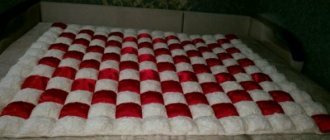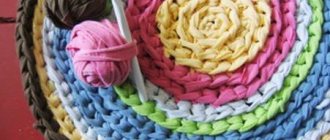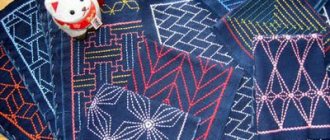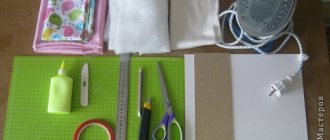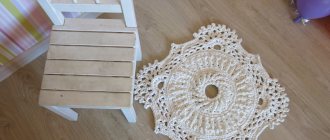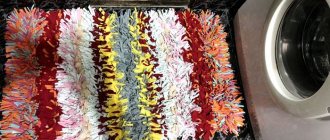Scraps and remnants of various fabrics are not garbage, but a real treasure in the hands of a needlewoman, which can be turned into amazingly beautiful and useful things, for example, rugs for a nursery, hallway or bathroom. There are so many ways to make rugs and rugs that you don’t even need to know how to sew and knit, you just need to choose the most convenient option for yourself.
DIY rugs made from scraps of fabric
After getting acquainted with the methods of making chair covers and sewing rugs, think about whether it is worth throwing away old T-shirts, jeans, towels, woolen sweaters and scarves. After all, all these things, even if they are shabby, with holes, faded in the sun, can be given a second life.
Patchwork fantasies
Bright rainbow rug
Preparation of flaps
Depending on the chosen technique for making the rug, scraps of fabric of different sizes and shapes may be required. It is better to select and cut the required amount in advance so as not to be distracted while working.
Preparing long strips of fabric for knitting or weaving a product can cause some difficulties: sewing them together is a long and tedious job. And if you tie them in knots, the rug will turn out rough and sloppy. But there are ways to avoid this.
Cutting continuous tape
This method is used when preparing fabric strips from old clothes: T-shirts, turtlenecks, T-shirts and even tights.
Step 1.
We cut off the rough bottom seam, the cuff of the sleeve or the toe part of the tights. For a T-shirt or turtleneck, cut off the top part right below the armholes.
Trimming seams
Step 2.
Place the product on a flat surface with the side seam facing you and cut it into strips of the required width, without cutting a couple of centimeters to the opposite seam.
Cutting strips
Step 3.
Thus, we cut the entire workpiece into fringe.
Workpiece cutting
Step 4.
We straighten the workpiece so that we can see the entire uncut part, and cut it not in a straight line, but at an angle, directing the scissors from one slot to the adjacent one on the other side of the product.
Cutting fabric
As a result, we get a closed ring, which to obtain a tape you just need to cut across one of the seams.
Blank for making a rug
Blanks can be wound into balls
Connection without node
If the length of the tape is not enough or you need to connect many short pieces with each other, the simple technique shown below will help you do this.
| Image | Description |
Step 1 | We cut small holes at the ends of adjacent strips that need to be connected. |
Step 2 | Place the strips on top of each other, aligning the slots. |
Step 3 | Pass the second end of the top strip through the slot from below and pull the entire strip through it. |
Step 4 | Tighten the connection. If necessary, repeat these steps to further lengthen the tape. |
Advice. If scraps of fabrics of different thicknesses and densities are used, then thinner ones should be cut into strips of greater width to even out the thickness of the weaving.
Knitted rugs from patches
From scraps joined into long ribbons, a rug can be crocheted, just as napkins are crocheted from ordinary yarn. True, for such work you need a large hook, 6-10 mm thick.
Begin work by tying a braid of 5-6 air loops, which are closed into a ring. Then the fabric is knitted in a spiral with double crochets, periodically knitting two stitches from one loop to increase the diameter. After each row, the work must be laid out on a flat surface to control the plane.
Crochet
Crocheting a rug
Video - Crocheting a round rug from cut fabric strips
Such a simple round rug does not require any special skill; even those who have picked up a crochet hook for the first time can knit it. If you have experience, you can create real masterpieces of any form.
Crochet rug
Handmade children's rug
Bright knitted rug
Multicolored rug
Braided rugs
You can weave a rug in different ways, and to do this, the scraps again need to be joined into long strips.
Braid rug
This method is very simple, it does not require any tools or equipment other than a needle and thread.
Step 1.
Sew three patchwork strips together.
Sew three patchwork strips together
Step 2.
We braid them into a regular braid. It should turn out to be quite long, so the strips will have to be extended as you work.
Braiding
Step 3.
We secure the end of the braid with a pin and begin to roll it in a spiral on a flat surface.
Twisting a braid
Step 4.
We fasten each turn to the previous one on the reverse side, sewing it with threads.
Sewing a braid
Step 5.
You can do it differently: first twist the entire braid, and then carefully sew the turns in a spiral.
Making a rug
An oval rug is made in the same way.
Braided rug
Terry mat-braid
Curly rug made from braids
Rug made of towels
But if you need a rectangular shape, it is better to weave several braids of the same length, lay them close to each other and sew them in a straight line. And weave the ends with cord or sew on a typewriter.
Scheme for making a rectangular rug
Rectangular woven rug
Advice. Such a rug will hold its shape better if you add a lining to it on the back side.
The lining can be an old towel
Braided rug
To make such a rug you need to make a frame for weaving. Its size should be slightly larger than the desired size of the canvas. Nails with small heads are placed on two opposite sides or wooden pins are installed to secure the base. The distance between them is 2-2.5 cm.
Weaving frame
Advice. If you add another intermediate crossbar to the frame, which can be attached at different levels, you can make rugs of different sizes.
Step 1.
We begin work by securing the warp threads. This can be cord, twine, thick yarn, or scraps tied into a long ribbon. The end of the tape is tied to the upper corner stud, after which it is snaked around all the pins of the upper and lower crossbars in turn. You need to stretch the base well, but not too tightly.
Fastening the warp threads
Step 2.
Preparing working threads. They should not be too long so as not to make weaving difficult. It is better to attach the next strip as you shorten the previous one.
Preparing working threads
Step 3.
We begin weaving by alternately passing a strip of working thread over and under the stretched warp threads.
Let's start weaving
Step 4.
Having reached the end of the row, we wrap the working thread around the outer warp thread and continue weaving in the other direction.
Weaving from the edge
Step 5.
Every few rows, compact the fabric by pulling the woven rows up. To do this, you can use a special device in the form of a wooden fork or simply use your hands. The denser the weaving itself and the smaller the distance between the rows, the less noticeable the warp threads will be.
Thread compaction device
Step 6.
We make the required number of rows, periodically increasing the working thread or changing it to a strip of a different color.
Weaving a rug
Step 7
If the color of the working thread needs to be changed at the edge of the rug, it is cut close to it and hemmed, or the next strip is tied to the cut end, and the knot is left on the wrong side. But you can do it differently: tie the strips on the edge, leaving long tails. In this case, the edges of the rug will be fringed.
Weaving a rug with fringe
For reference. The fringe on the other two sides can also be done at once, if you do not wind the warp threads around the pins, but tie them to each pair with separate strips.
Chair cover with fringe
At the end of the work, the canvas is carefully removed from the nails.
You can complicate the weaving by taking two working threads instead of one at once, and interweaving them both with each other and with the warp threads.
How to weave a rug without a loom
Video - Rug made of shreds on a frame
You can also weave a round rug in a similar way. A hoop can serve as a frame for it.
Round wicker rug
The process of weaving a rug on a hoop
Knotted rug
To make such a shaggy rug, you don’t need to sew the scraps into ribbons. They just need to be cut into strips 8-12 cm long, depending on how long the “pile” you want to get.
In addition to them, the work will require a crochet hook and a special mesh for carpets, which can easily be replaced with a synthetic construction mesh. The base of the desired shape and size is cut out of it.
Carpet mesh
Then the strips folded in half are slipped under the mesh, and their ends are pulled out to the front side on both sides of the cell wall using a hook. All that remains is to tie them with a strong knot.
Blanks from an old T-shirt
Stripes tied into knots
The longer the ropes, the fluffier the rug.
All grid cells are filled in the same way.
Using scraps of different colors, you can create patterns and ornaments from them according to a pre-designed scheme.
Soft patch rug
Heart shaped rug
Round rug
The simplest version of a rug made from scraps of fabric is round. To make it you will need:
- Old fabric items;
- Scissors;
- Needle;
- Threads.
If you just want to recycle old items by creating a shoe mat, feel free to use any fabric. If you have ideas to fit this product into the interior, carefully select the color and texture of the fabric.
Start by cutting the fabric into long strips.
If the fabric is fraying a lot, it is better to sew each strip and turn it inside out, leaving the seam inside. This is quite a labor-intensive task, but a product made from treated fabric looks neater and will last longer.
From the resulting pieces of fabric you need to weave a braid. The tighter it is, the stiffer the resulting rug will be; therefore, if you want a soft rug, then do not twist the braid too much.
Secure the ends of the scraps with a pin.
And start weaving.
Having reached the end of the ropes, you need to lengthen them. If you tie a knot, it will turn out rough and ugly. There are two options - carefully sew on a new end or make cuts at the ends of the flaps and stretch an additional rope through the working end and insert its tail into the cut. Pull gently and you have a long rope without any knots or stitching. The whole process is clearly visible in the photo:
You need to make a long enough braid.
Related article: DIY watch bracelet made from rubber bands and beads with video
Do not process its ends yet, but simply grab them with a pin so that they do not unravel. If during the process of making the rug you want it to be larger, simply attach new pieces of fabric and braid it until you get the desired diameter of the finished rug.
Next, you need to assemble the rug itself. To do this, carefully twist the braid in a spiral, catching it with thread in several places of the weave.
You can braid the braid with ribbon instead of thread. To do this, weave it with zigzag stitches either into the side of the carpet or into the working braid thread. Pull the tape and it will connect the parts together.
For greater strength, it is better to completely weave or stitch the edge row of the rug, then the product will definitely not fall apart.
The round rug is ready!
Patchwork pompom rugs
Very soft and cozy rugs are made from patchwork pompoms filled with holofiber, padding polyester or foam rubber. You don’t have to buy filler either - you can “get it” from old jackets, blankets and stray pillows.
The choice of patches depends on the purpose of the rug. For children, old knitted T-shirts and T-shirts in bright colors are best suited.
To work you need to prepare:
- a large number of scraps or old unnecessary knitwear;
- needle and thread;
- scissors;
- filler;
- thick fabric for the base;
- glue gun
Step 1.
We cut out circles of the same size from the knitwear according to the template. Their diameter should be approximately twice the intended diameter of the pom poms.
Cut out circles
Step 2.
Using a simple stitch, we quilt the blanks in a circle, stepping back a little from the edge.
Quilting the workpiece around the circumference
Step 3.
Place filler in the middle and tighten the thread. We get a soft ball.
Filling included inside
Step 4.
We make such balls from all the blanks.
Preparing pompoms
Step 5.
We cut out the base for the rug from the fabric and use a glue gun to sequentially glue patchwork pompoms to it. They can also be sewn on.
Attaching pompoms to the base
To make a similar rug for the bedroom, you can take a coarser and more wear-resistant fabric, and for the bathroom - old terry towels.
Rug made of pompoms
Old rugs and bedspreads of strict monochromatic colors will make an interesting rug in the shape of flowers or a clearing. If the fabric is thick and dense enough, you can even do without filler or use very little of it.
Rug "Polyanka"
Rug made of pompoms in the shape of a leopard skin
The manufacturing algorithm is the same, with minor nuances.
| Step, no. | Description |
1 | We cut out a base from the fabric in the shape of the future rug. From working fabric and scraps we cut out rounded oval and round shapes to create “stones”. We make them quite large. |
2 | We bend the edges of the blanks inward and sew them on the wrong side. If they are not voluminous enough, put a little synthetic padding inside. |
3 | We prepare the required number of parts so that they fill the entire area of the cut base. It is advisable to make “pebbles” of different textures, shapes and sizes to make the rug look more natural. |
4 | We lay out the blanks on the base in the required order and sew the adjacent ones together. |
5 | Sew the “pebbles” to the base fabric. |
6 | We especially carefully fasten all the parts around the perimeter of the rug together. |
7 | We cut out the backing from thick fabric according to the size of the resulting product, making small allowances for the hem. And we sew them together along the edge. |
DIY rugs made from pompoms
Making pompoms is not difficult, it just takes a long time. For a rug you will need many dozens of them. Doing one at a time takes too long. There is a method that allows you to make up to a dozen pom-poms in one go. Moreover, they will all be of the same density. All you need is a regular chair, thread and scissors.
Preparation of pompoms
Turn the chair upside down. We wrap threads around the legs as a base. In the photo they are wound on two legs, but if you need a lot of identical pompoms, you can wind them on four at once.
How to make pompoms from threads quickly
Having wound the required number of turns, we take it and pull it with threads over a certain distance. Pull tightly, pulling with all your might. Having made several constrictions on the chair, remove the tourniquet and continue making constrictions. The distance between them will be approximately equal to the size of the pompom. In reality, the pompoms turn out a little smaller (about 1 cm), so take this into account.
We take scissors and cut between the two constrictions in the middle. It's not that easy to do. Especially if the constrictions are close and the thread bundle is thick. We straighten the cut pompoms, cutting off the protruding threads. We get a dozen or more balls of thread at a time. Repeat with a different color or size.
By the way, you can also make pompoms from knitted ribbons, cut from old T-shirts or fabric. Everything is the same: winding, tying, cutting. Pom-poms look and feel different, but no less attractive.
You can make pompoms from old knitwear or towels
We recommend making the threads used to tie the tourniquet longer—leaving at least 10 centimeters of hanging ends. Then it will be easier to assemble the rug.
Base for rug with pompoms
Pompoms can be tied to any net. An anti-slip carpet underlay is best. You can take a piece of rubber mats that are sold by the meter for bathrooms. They also have holes, but they are much smaller. What's good about these options? They don't slip.
DIY rugs: base for a carpet with pom-poms
You can use a painting mesh with a large mesh, or even just a piece of fabric. But we tie pompoms to the mesh, but to the fabric we have to either sew them, which takes longer, or glue them, which is not so reliable.
Assembly and drawings
A rug made of pompoms is suitable for a child's room. Due to the fact that it can be made from multi-colored pompoms, it will attract the child's attention. The interesting texture of the rug also arouses curiosity. If you use pompoms of different sizes and colors, from different threads - smooth, prickly, shaggy - you can make an “educational” rug for babies. Children need to develop tactile skills and this rug will help.
Here's how to make your own rugs from pompoms
If you use pom-poms made of cotton, microfiber and other highly absorbent materials, you can place such a rug in the bathroom. It is very soft and pleasant. From small-sized pompoms, but tightly packed, you can assemble round, oval, flower-shaped, animal-shaped or any other shape.
We tie pompoms to the net
If you have found a mesh base, we thread the threads that remain after tying the pompoms through the mesh and tie them to several knots. If you have a hook, it is easier to use it to pull the threads through the cells. You need to tie it firmly; you can pull the threads through different cells several times, tightening them each time. This is important if you plan to machine wash the rug.
Can be glued to fabric using a glue gun
Pompoms can be glued or sewn onto fabric. If you plan to wash, glue is unlikely to work. The gluing option will not work if there are small children in the family. If they manage to tear off the pom pom, it will definitely end up in their mouth.
By the way, pompoms can be sewn. To do this, you will need to cut circles of different diameters, sew them along the edges with large stitches, fill them with padding polyester, padding polyester, etc. and pull the thread. See the video below for more details.
Rugs made from patchwork corners
This method is suitable only for craftswomen who are good at machine sewing.
Rug made of triangles
To make such unusual and very beautiful rugs you will need scraps of fabric of the same density.
| Step, no. | Description |
1 | We cut identical squares from the fabric with a side of about 10 cm and fold them twice diagonally. |
2 | We pin the resulting corners to the fabric, forming the middle of the rug. And we attach them along the edge using a typewriter. |
3 | We lay the next row so as to close the seam, shifting the corners relative to the ones already hemmed. |
4 | Having sewn the second row, we form the third and subsequent ones in the same way, gradually expanding the circle. |
5 | We attach the last row close to the edge and finish it with bias tape. |
In the example described, the corners of the patches look into the middle of the rug. But you can do the opposite: start sewing the triangles not from the center, but from the edge of the product, turning them outward. In this case, you will have to decorate the middle with a round patch.
From the scraps you can make not only corners, but also other shapes - petals, scales, beaks, etc.
Beautiful rug in the shape of a flower
Such different rugs are made from scraps of fabric and old things that no one wears anymore. Instead of adding to the amount of waste on the planet, you can put old things to good use, while decorating your home and saving money on buying rugs, pet bedding and kitchen stool covers.
Denim rug
Rugs made from old jeans
Rugs made from old things, what will be used?
We learned about techniques for creating a rug from old things, now it’s worth talking about what can serve as material for them and how best to bring your idea to life.
Taking into account the density, quality and size of the old item, you can choose the method of its transformation. That is why we would like to tell you a little about how and what rugs are made from by modern needlewomen.
Rugs made from old jeans
The first thing that comes to mind that requires regular disposal is jeans. Denim has long conquered our hearts and there is not a single fashionista or fashionista who does not have jeans in her wardrobe. Moreover, despite their strength and versatility, they still wear out, stretch, or otherwise become unusable.
Of course, it’s a shame to throw them away, so we collect them on a separate shelf so that we can sew something later.
But sewing requires patterns, a sewing machine, and sometimes also space. While making a rug from old jeans with your own hands will not be difficult at all - everything from the canvas to the pockets and belt will be used.
Just choose a technique and select flaps for it:
- cut them into long strips and weave a rug on a loom,
- weave long braids and gather them into a round rug,
- arm yourself with a large hook and knit any shape using cut strips instead of yarn,
- weave the strips together using the braiding principle and sew on a machine or by hand.
Gray jeans will also work
And the cat liked it)
Considering the strength of the material, such a rug will serve you for more than one season.
Rugs made from old T-shirts
But we wear out T-shirts more often than jeans. After all, we use them every day, grow out of them, stretch them, get dirty with paint and simply get tired of them over time.
You may not be able to wear them anymore, but the knitwear used to make T-shirts can be an excellent material for creativity. They make great potholders, coasters, bags and, of course, rugs.
How to make knitting yarn with your own hands
When we look at these DIY rugs made from old T-shirts, at first we can't believe what they're made of! After all, craftswomen knit with crochet from something very similar to yarn, and not like an old T-shirt.
However, do not be surprised by this and do not think that there is some kind of trick here. Anyone can turn old T-shirts into knitting yarn.
To do this, just follow the detailed video master class on the Utilitarian Crafts channel, in which they will teach us how to make as much yarn as possible from an old T-shirt for new rugs.
